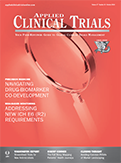How to Avoid Common Pitfalls of Market Landscaping
Applied Clinical Trials
Key tips and resources to help evade the common traps of market landscaping-today an increasingly high-stakes and comprehensive task during clinical development.
An Nguyen

Developing a new drug is a time-consuming and expensive proposition: on average, it takes $2.5 billion and 10-plus years, according to the Tufts Center for the Study of Drug Development. With costs and stakes that high, biopharmaceutical companies simply cannot have too much information about the market they are planning on investing in.
Market landscaping: Know the market well
Market landscaping is extensive, objective research that explores the target market. Regardless of the industry, market landscaping generates information about market size, market share, trends and dynamics, the competitive environment, risk factors, and barriers to entry.
Market landscaping in the pharmaceutical industry goes deeper to include detailed scientific and clinical knowledge about the therapeutic area unmet patient needs and perceptions, the cause of disease and its impact on the patient’s physiology, prescribing data, current treatment regimens and how they fall short, approaches competitors are using, as well as data from ongoing clinical trials. In short, any and all information that will help draw a detailed picture of what drives the market for a specific therapy and what roadblocks could make entering that market a losing proposition.
Market landscaping pitfalls to avoid
Comprehensive market landscaping includes disparate data sets from primary and secondary sources and is a time-consuming process that requires domain expertise and commitment. Common pitfalls of do-it-yourself (DIY) market landscaping are:
• Missing relevant clinical data by only including U.S.-based clinical trials. ClinicalTrials.gov is a terrific resource that covers all 50 states as well as trials abroad, but double-checking using the WHO International Clinical Trials Registry Platform can fill in the gaps.
• Missing companies in stealth mode. These organizations are flying under the radar and, therefore, information will be hard to find. However, even these companies leave digital breadcrumbs in the form of review articles, news releases, patent applications, and even on their social media feeds.
• Ignoring the failures. You can learn a lot from trials gone awry: was it toxicity that killed the compound, patient recruitment or compliance, side effects, funding issues? Knowing what did not work helps you avoid making the same mistake.
• Ignoring history. The latest protocol and paper are certainly the most relevant, but there are important lessons to be learned from changes a sponsor made to enrollment sites, patient stratification, outcome measures, etc. that can provide valuable insight for your market assessment.
• Making your market landscaping a snapshot rather than a living, changing document. New information is released every day, new trials are registered and revised daily, making market landscaping an ongoing project.
Market landscaping resources
If you do your own market landscaping rather than hire a professional firm, here are some helpful resources and suggestions:
• Identify existing products and companies: AdisInsight, ClinicalTrials.gov, WHO International Trial Search Portal, DrugBank, LinkedIn.
• Collect product and company updates: news releases (Google News, PR Newswire); conference abstracts, Google Scholar, industry conference websites; investor presentations (SEC filings, company websites, conference presentations.)
• Dig into the science behind the products with clinical trial design, e.g., clinical trials registry, published protocols in conference abstracts and journals.
• Stay on top of the landscape with Google alerts, RSS feed for Clinical Trials, and calendar reminders for the next expected readouts.
Comprehensive market landscaping is a crucial component in the effort to de-risk the expensive, long-term strategic bet on a disease area. It takes analytical rigor, an ability to connect disparate facts, and a creative mind to connect objective facts, data, and information with intangibles like emotional factors that influence patients in their decision-making. The rich trove of information created in market landscaping will help a pharmaceutical company draw an accurate picture of their target market and identify key opportunities.
An Nguyen is Head of Strategy at H1
